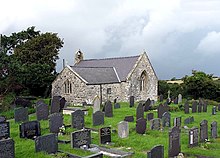
St Pabo's Church, Llanbabo is a medieval church in Llanbabo, in Anglesey, North Wales. Much of the church dates to the 12th century, and it is regarded as a good example of a church of its period that has retained many aspects of its original fabric. The church houses a tombstone slab from the 14th century, depicting a king with crown and sceptre, bearing the name of Pabo Post Prydain, the reputed founder of the church. However, there is no evidence that Pabo, a 5th-century prince, lived in the area and the tradition that he founded the church has little supporting basis.
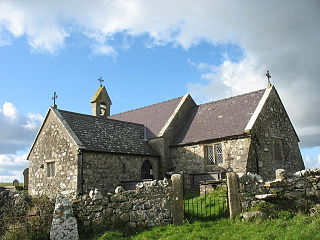
St Peulan's Church, Llanbeulan is a redundant Anglican church in Llanbeulan, in Anglesey, north Wales. The nave, which is the oldest part of the building, dates from the 12th century, with a chancel and side chapel added in the 14th century. The church has a font of early date, possibly from the first half of the 11th century: one historian has said that it would initially have been used as an altar and that "as an altar of the pre-Norman period it is a unique survivor in Wales and, indeed, in Britain".

St Cristiolus's Church, Llangristiolus is a medieval church near the village of Llangristiolus, in Anglesey, north Wales. The village, about 1 mile (1.6 km) from the building, takes its name from the church. Reputedly founded by St Cristiolus in 610, the present building dates from the 12th and 13th centuries. Alterations were made in the 16th century, when the large east window in Perpendicular style was added to the chancel – a window which has been described by one guide to the buildings of north Wales as "almost too big to fit" in the wall. Some restoration work took place in the mid-19th century, when further windows were added and the chancel largely rebuilt.

St Mary's Church, Tal-y-llyn is a medieval church near Aberffraw in Anglesey, north Wales. It was originally a chapel of ease for the parish church of St Peulan's, Llanbeulan, but the township that it once served, Tal-y-llyn, no longer exists. It was declared a redundant church in the early 1990s, and has been in the care of the Friends of Friendless Churches since 1999. Services are held once per month during part of the year.
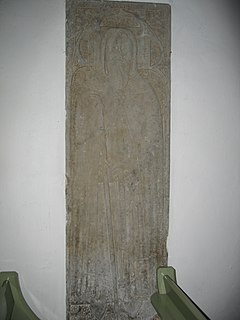
Iestyn was a Welsh hermit and confessor in the 6th or 7th century who is venerated as a saint. He was the founder of two churches, one in Gwynedd and another in Anglesey, both in north Wales.
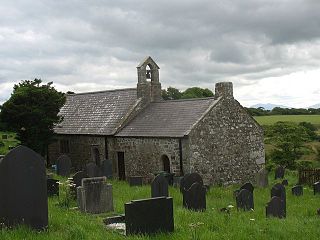
St Cwyllog's Church, Llangwyllog, is a medieval church near Llangwyllog, in Anglesey, north Wales. St Cwyllog founded a church here in the 6th century, although the exact date is unknown. The existence of a church here was recorded in 1254 and parts of the present building may date from around 1200. Other parts are from the 15th century, with an unusual annexe added in the 16th century. The church contains some 18th-century fittings, including a rare Georgian three-decker pulpit and reading desk.

St Eleth's Church, Amlwch is a parish church built in the Neo-classical style in 1800 in Amlwch, a town on the island of Anglesey in north Wales. It stands on the site of earlier buildings, with the first church here said to have been established by St Elaeth in the 6th century. Increasing prosperity in the town through copper mining during the 18th century led to the construction of a new church to serve the growing population.

St Fflewin's Church, Llanfflewin is a small rural church, situated by a farm in Anglesey, Wales. The first church on the site is said to have been built by St Fflewin in 630, but the present building has no structural features dating from before the 18th century, although the church has a font from the 14th or 15th century and part of an inscribed medieval gravestone has been reused in a window sill.

St Tyfrydog's Church, Llandyfrydog is a small medieval church, in Llandyfrydog, Anglesey, north Wales. The date of establishment of a church on this site is unknown, but one 19th-century Anglesey historian says that it was about 450. The oldest parts of the present building are dated to about 1400, with the chancel dating from the late 15th or early 16th century. It is built from rough, small, squared stones, dressed with limestone. One of the windows on the south side is raised to illuminate the pulpit, a decision that in the eyes of one 19th-century commentator "disfigures the building."
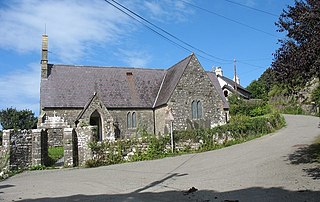
St Dona's Church, Llanddona ) is a small 19th-century parish church in the village of Llanddona, in Anglesey, north Wales. The first church on this site was built in 610. The present building on the site dates from 1873, and was designed by the rector at the time. It reuses earlier material including a decorated 15th-century doorway and a 17th-century bell.

St Caian's Church, Tregaian, also known as St Caean's Church, Tregaean, is a small medieval church dating from the 14th century in Anglesey, north Wales. It is dedicated to St Caian, a Christian from the 5th or 6th century about whom little is known. The building contains a late 14th-century east window and a late 15th-century doorway. The churchyard contains the grave of William ap Howel, who died in 1581 at the age of 105, leaving over forty children between the ages of 8 and 89 and over three hundred living descendants.

St Gallgo's Church, Llanallgo is a small church near the village of Llanallgo, on the east coast of Anglesey, north Wales. The chancel and transepts, which are the oldest features of the present building, date from the late 15th century, but there has been a church on the site since the 6th or early 7th century, making it one of the oldest Christian sites in Anglesey. Some restoration and enlargement took place during the 19th century.

St Beuno's Church, Trefdraeth is the medieval parish church of Trefdraeth, a hamlet in Anglesey, north Wales. Although one 19th-century historian recorded that the first church on this location was reportedly established in about 616, no part of any 7th-century structure survives; the oldest parts of the present building date are from the 13th century. Alterations were made in subsequent centuries, but few of them during the 19th century, a time when many other churches in Anglesey were rebuilt or were restored.

St Nidan's Church, Llanidan is a 19th-century parish church near the village of Brynsiencyn, in Anglesey, north Wales. Built between 1839 and 1843, it replaced the Old Church of St Nidan, Llanidan, which needed significant repair, providing a place of Anglican worship nearer to the village than the old church. Some items were moved here from the old church, including the 13th-century font, two bells from the 14th and 15th century, and a reliquary thought to hold the remains of St Nidan. The tower at the west end has been described as "top heavy" and looking like "a water tower".
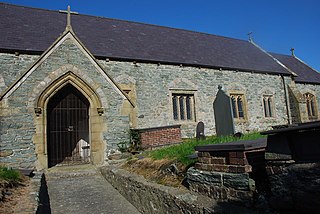
St Edern's Church, Bodedern is a medieval parish church in the village of Bodedern, in Anglesey, north Wales. Although St Edern established a church in the area in the 6th century, the oldest parts of the present building date from the 14th century. Subsequent alterations include the addition of some windows in the 15th century, and a chancel, transept and porch in the 19th century, when the nave walls were largely rebuilt. Stained glass was also inserted into the windows of the chancel and transept.

St Eugrad's Church, Llaneugrad is an isolated church near the village of Marian-glas, in Anglesey, north Wales. A church was supposedly founded here by St Eugrad in about 605, although the earliest parts of the present structure are the nave, chancel and chancel arch, which date from the 12th century. A side chapel was added to the north in the 16th century, and some moderate restoration work was carried out in the 19th century. It contains a 12th-century font, a 13th-century carved stone depicting the crucifixion, and a memorial to one of the officers killed when the Royal Charter sank off Anglesey in 1859.

St Mary's Church, Llanfair-yng-Nghornwy is a medieval parish church in the north-west of Anglesey, north Wales. The date of foundation of the church, which is in the village of Llanfair-yng-Nghornwy, is unknown, but the oldest parts date from the 11th or 12th century. It has twice been enlarged: in the 15th century, when the chancel was rebuilt, and in the 16th century, when a chapel was added to the south of the chancel, separated by three arches. The tower at the west end is from the 17th century. A south porch of unknown date has been converted into a vestry, and the church is now entered through the tower.
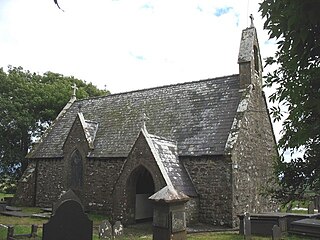
St Cynfarwy's Church is a medieval parish church in Llechgynfarwy, Anglesey, north Wales. The first church in the vicinity was established by St Cynfarwy in about 630, but no structure from that time survives. The present building contains a 12th-century baptismal font, indicating the presence of a church at that time, although extensive rebuilding in 1867 removed the datable features of the previous edifice.

St Mary's Church, Llanfair-yn-y-Cwmwd is a small medieval parish church near the village of Dwyran, in Anglesey, north Wales. The building probably dates from the 15th century, with some alterations. It contains a 12th-century carved stone font and a 13th-century decorated coffin lid. The bell is inscribed with the year of its casting, 1582. The historian Henry Rowlands was vicar of St Mary's in the late 17th and early 18th centuries. Maurice Wilks, who invented the Land Rover, is buried in the churchyard.

St Peter's Church, Llanbedrgoch, is a small medieval parish church near the village of Llanbedrgoch in Anglesey, north Wales. The oldest parts of the building date from the 15th century; it was extended in the 17th century and restored twice in the 19th century. The doorway is decorated with carvings of two human heads, one wearing a mitre. The church contains a reading desk made from 15th-century bench ends, one carved with a mermaid holding a mirror and comb.
